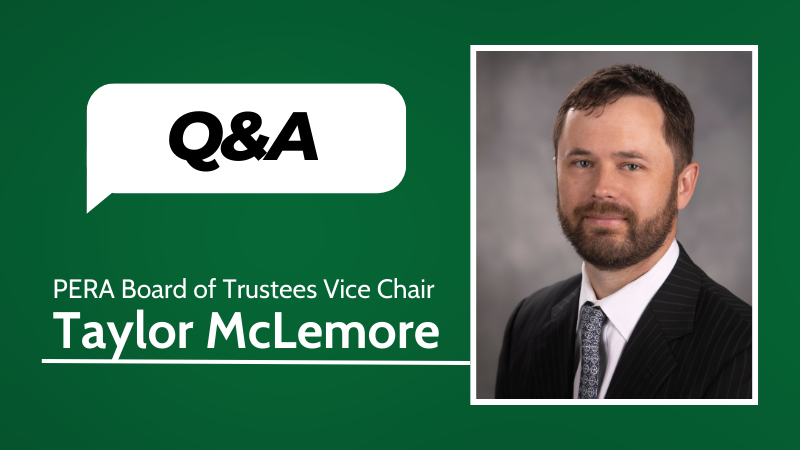Colorado PERA works diligently to provide a stable and secure retirement for Colorado’s public workers. Though most PERA members participate in its hybrid defined benefit (DB) plan, many members also contribute additional supplemental savings to either the PERAPlus 401(k) or 457 Plans. Additionally, a smaller number of PERA members are eligible to choose the PERAChoice DC Plan instead of the hybrid DB plan.
Together the PERAPlus and PERAChoice plans make up PERA’s defined contribution (DC) portfolio, with total assets of $3.2 billion and $130 million respectively. Recently, PERA was recognized for its innovative DC plan structure when it was asked to present at the annual conference of the National Association of Government defined contribution Administrators, Inc. (NAGDCA).
The leading association for defined contribution retirement plans (such as 401(k) or 457 plans) sponsored by government employers, NAGDCA brings together representatives from state and local governments with private sector organizations that service and support DC plans. NAGDCA works to enhance government DC retirement plans so that they can provide their participants with financial security at retirement.
NAGDCA’s annual conference focuses on topics of interest to its members and incorporates case studies from successful DC plans to foster collaboration and provide education. This year, Jeffrey Cable, Colorado PERA defined contribution Manager, presented Colorado’s DC plan structure as an example case study of a successful plan. Cable joined representatives from the City of Los Angeles and Missouri in discussing innovative DC plan designs.
In 2011, PERA restructured its investment options for the DC plans by creating “white label funds.” White label funds are titled based on the investment options they contain, rather than the investment manager retail name. This innovation helps to achieve PERA’s goal of encouraging DC plan participants to focus on aligning the allocation of their assets with their retirement savings needs.
Most PERA members who participate in the DC plans are invested in the PERAdvantage funds:
- PERAdvantage Capital Preservation Fund
- PERAdvantage Fixed Income Fund
- PERAdvantage Real Return Fund
- PERAdvantage U.S. Large Cap Stock Fund
- PERAdvantage U.S. Small and Mid Cap Stock Fund
- PERAdvantage International Stock Fund
- PERAdvantage SRI Fund
Each of the fund options contains multiple underlying funds, which offer differing characteristics. The underlying funds include both actively and passively managed funds, and are combined to provide diversified exposure to the represented asset class.
For those participants who prefer an asset allocation strategy determined by their planned retirement date, the DC plans offer Target Date Funds. These funds include a variety of different investment styles or asset classes and are designed to reach a savings goal by a set or “target” date.
Additionally, some participants invest using the self-directed brokerage, which allows investors significant control and customization of their investments.
PERA has lowered the costs of its plans for participants by implementing the white label approach along with using a combination of index (passive) funds and leveraging the size of dollars invested. PERAdvantage Funds are low in cost and best in class.
Research has shown that high investment fees can negatively impact retirement savings over time. That’s why it’s important to understand the fees associated with investing. PERA redesigned the DC plans in 2011 to ensure members’ supplemental (and in the DC Plan, mandatory) savings are not eroded by high fees.
By structuring its DC plans to allow participants to concentrate on portfolio diversification while having compelling investment choices, PERA provides DC plan participants with another option to save more for retirement while getting the most benefit from their savings. All PERA members are encouraged to save in addition to their PERA defined benefit plan and the PERAPlus plans offer easy to understand, low cost ways to save for retirement.
See PERA on the Issues “The Importance of Understanding Investment Fees”
Asset classesA category of similar investments. Common asset classes include global equity (such as publicly traded stocks), real estate, and cash.Hybrid defined benefitPERA’s Defined Benefit (DB) Plan is “hybrid” in that it combines features of a traditional DB plan with some of the features of defined contribution (DC) plans, such as portability.Defined benefitAlso known as a pension, this is a type of pooled retirement plan in which the plan promises to pay a lifetime benefit to the employee at retirement. The plan manages investments on behalf of members, and the retirement benefit is based on factors such as age at retirement, years of employment and salary history.Defined contributionA type of individual retirement plan in which an employee saves a portion of each paycheck (along with a potential employer match) and invests that money. The employee’s retirement benefit is based on their account balance at retirement. A 401(k) is a type of defined contribution plan.Defined contributionA type of individual retirement plan in which an employee saves a portion of each paycheck (along with a potential employer match) and invests that money. The employee’s retirement benefit is based on their account balance at retirement. A 401(k) is a type of defined contribution plan.Asset allocationAn investor’s mix of stocks, bonds, and other investments. PERA’s strategic asset allocation is set by the PERA Board of Trustees.Fixed incomeA type of investment that pays investors a fixed rate of interest over a set period of time. Bonds are a common type of fixed income investment.Asset classA category of similar investments. Common asset classes include global equity (such as publicly traded stocks), real estate, and cash.Asset classA category of similar investments. Common asset classes include global equity (such as publicly traded stocks), real estate, and cash.




